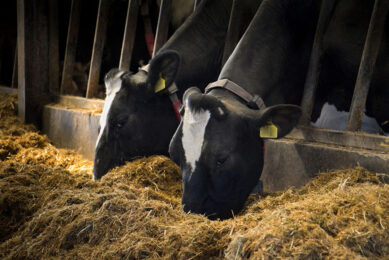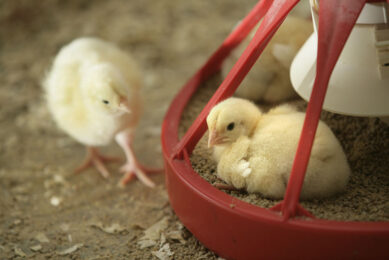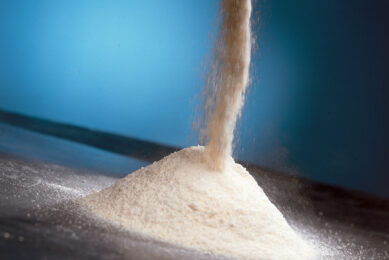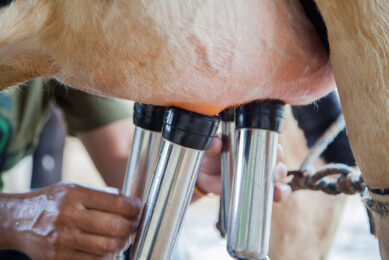Japanese technology thrives at French malting specialist
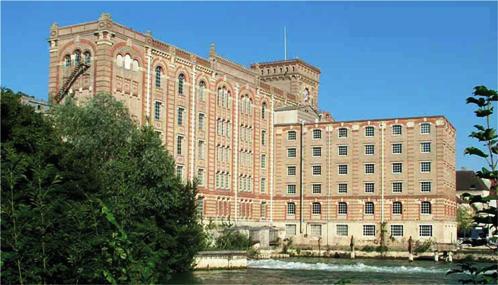
Privately owned malting specialist Soufflet, headed by Jean Michel Soufflet since 2000, introduced its new feed ingredient Avimalt Plus to the market, some three years ago. The product is now available for pigs, poultry and ruminants. The company has also expanded its R&D considerably with the aim to further improve the product and the technology of solid state fermentation.
The headquarters of the Soufflet Group are located in Nogent-sur-Seine, a small town in the northern part of France in the middle of far stretching grain fields and some 100 km south east of Paris. The office building is impressive situated in an old hydro-powered grain mill, which now only has a historical function, but the river is still running underneath the building as it has been for more than a hundred years. Apart from the Soufflet Group the town is also known for its nuclear power plant, with two smoking chimneys that can be seen from far. The main business of Soufflet is the malting of barley. Large brewery plants from all over the world are customers of the company. With €10 million turnover in biotechnology the solid state fermentation unit is only a tiny division compared to the other activities of Soufflet (see Table 1), but an increasing one.
Last time I visited the office building a part of it was still empty and only functioned as a heritage of history. But since then much has changed. The last two years a lot of money and effort has been spent to build an extensive biotechnological laboratory including a laboratory scale plant for solid state fermentation.
Solid State Fermentation (SSF) has existed for several centuries. It has been used in Asia and Japan where it was referred to as “Koji” fermentation. This process (Figure 1) consists of depositing a solid culture substrate such as rice or wheat bran on flatbeds after seeding it with micro-organisms; the substrate is then left in a tempered room for several days. In contrast, Liquid State Fermentation is performed all over the world, in tanks, which, at an industrial scale reaching 1,000 to 2,500m2. LSF requires a lot of water and energy, whereas SSF is the cultivation of micro-organisms under controlled conditions in the absence of free water. Examples of products of SSF include industrial enzymes and nutrient enriched animal feeds. The application of modern biotechnical knowledge and process control technologies can lead to significant productivity increases from this ancient process.
Surface area
Maintenance of adequate moisture level in the solid matrix along with suitable water activity are essential elements for SSF processes. Solid substrates should generally have a large surface area per unit volume (app.103-106 m2/cm3 for the ready growth on outside of the substrate). Smaller substrate particles provide larger surface area for microbial attack but pose difficulty in aeration/respiration due to limitation in inter-particle space availability. Larger particles provide better aeration/respiration opportunities but provide lesser surface area. For cost effectiveness in bioprocess optimisation, sometimes it may be necessary to use a compromised size of particles (usually a mixed range). Soufflet is very active in the selection of optimal substrates, either raw materials or preferably co-products of the agro-industry.
Maintenance of adequate moisture level in the solid matrix along with suitable water activity are essential elements for SSF processes. Solid substrates should generally have a large surface area per unit volume (app.103-106 m2/cm3 for the ready growth on outside of the substrate). Smaller substrate particles provide larger surface area for microbial attack but pose difficulty in aeration/respiration due to limitation in inter-particle space availability. Larger particles provide better aeration/respiration opportunities but provide lesser surface area. For cost effectiveness in bioprocess optimisation, sometimes it may be necessary to use a compromised size of particles (usually a mixed range). Soufflet is very active in the selection of optimal substrates, either raw materials or preferably co-products of the agro-industry.
The SSF process and ingredients are managed by subsidiary Lyven, which has been part of Soufflet Ingredients since 2003. Lyven produces enzymes on an industrial scale by solid state fermentation on natural substrate using non GMO selected strains which are widely accepted in the feed and food industry. Lyven has a strong expertise on enzymatic activities, such as measurements, formulation, etc.
Optimise the process
Soufflet is determined to optimise the SSF process. In the new laboratory several small fermenters are installed, some of which are obtained from Japanese suppliers – the home of the technology. In the fermenters tests with substrates and microorganisms can be carried out from 100 grammes to 20 kg. In a nearby location batches of 1,000 kg can be processed and in Arcis-sur-Aube (about 50 km east of Nogent) an industrial SSF plant is situated. Currently more than 100 employees work on biotechnology, of which 60 in research on SSF and its applications. Their work concentrates on improving the substrate, the microorganism and the process.
The basis for the Avimalt product is wheat. Soufflet does not use genetically modified products. There is enough variety in natural organisms to go forward is their statement. One tonne of microorganisms infused substrate in SSF delivers one tonne of Avimalt. Annual output is about 1,000 tonnes. Now the product is mainly sold for monogastric feeds. Only 5% is sold for ruminant feeds, but this sector has great potential. In cows the product seems to have a booster effect on the bacteria in the rumen and to allow the right bacteria to do better what they are supposed to do: digest the forage.
Research programme
The Soufflet group launched in 2008, with the support of the French public agency Oseo, a R&D programme (named Osiris) based on solid state fermentation of agricultural resources and its applications. The programme entails a €70 million investment over an eight year period and in four fields of application:
The Soufflet group launched in 2008, with the support of the French public agency Oseo, a R&D programme (named Osiris) based on solid state fermentation of agricultural resources and its applications. The programme entails a €70 million investment over an eight year period and in four fields of application:
- Crops bioprotection,
- Nutrition and health beverages,
- Bioethanol production (ingredients) and
- Animal feed (enhancing the digestibility of biofuels byproducts).
After a strong involvement in primary processing over the last 40 years, Soufflet is now working hard on R&D on secondary processing, including the development of a new catalyst for animal feed and utilising the synergies between the malting unit and Lyven. The target is to develop the existing range of complementary feeding stuffs (Avimalt) and to create new ranges especially fitted to biofuels byproducts.
Practical trials
The development of the SSF product goes back further than 2008. Already in 2006 a promising trial was carried out at the University of Leuven in Belgium where broilers were fed a standard feed complemented with 1, 1.5 and 2 kg of Avimalt/tonne respectively. It was found that the product improved Average Daily Gain by 3% to 5% compared to the negative control and also performed better than the positive control feed. There was a clear dose effect on weight. Feed conversion decreased compared to negative control (-5% to -8%) and also compared to positive control (-1% to -5 %).
The development of the SSF product goes back further than 2008. Already in 2006 a promising trial was carried out at the University of Leuven in Belgium where broilers were fed a standard feed complemented with 1, 1.5 and 2 kg of Avimalt/tonne respectively. It was found that the product improved Average Daily Gain by 3% to 5% compared to the negative control and also performed better than the positive control feed. There was a clear dose effect on weight. Feed conversion decreased compared to negative control (-5% to -8%) and also compared to positive control (-1% to -5 %).
In more recent trials Avimalt Plus was evaluated compared to negative and positive controls, on a corn-soy diet, after encouraging trials in Taiwan, South Africa and Argentina.At Nouzilly (France), with INRA and Itavi, in July and August 2010 trials were carried out in floor pens with pelleted feed. Diets fed were: positive control (classical corn -soy diet), negative control (corn- soy diet, deficient in energy, amino acids and proteins), Avimalt Plus at 500 g/t or 1kg/t added on negative control. The addition of 500 g/T had no effect compared to the negative control. Positive control and Avimalt Plus at 1 kg/T behave similarly, with a net difference compared to negative control and 500 g/T, especially on FCR. As a consequence, the addition of 1 kg of Avimalt Plus in this trial compensated the 2 to 4% deficiency in proteins, energy and amino acids.In turkeys Avimalt was tested with a private partner in France in 2007. Improvement of ADG was 2% compared to negative control (1% compared to positive control). An improvement of 6% was observed during finishing stages compared to negative control (3% // positive control). FCR was decreased by 2% compared to negative control. A stronger effect of the feed ingredient on FCR was observed during finishing stages: -5% on negative control and -2% on positive control.Avimalt use in pigs is more recent than in poultry. A 6-week trial with piglets at a British feed producer in September 2009 showed a significant improvement of FCR (-3.5% at 500 g/T) and no difference on ADG.
Promising in ruminants
Ruminants, with their completely different digestion tract and ration needs, are, according to Soufflet, the most promising sector for Avimalt. Four trials with bulls, calves and dairy cows carried out in 2010 and 2011 showed the following outcomes:
Ruminants, with their completely different digestion tract and ration needs, are, according to Soufflet, the most promising sector for Avimalt. Four trials with bulls, calves and dairy cows carried out in 2010 and 2011 showed the following outcomes:
- Young bulls (8 months, 30 g/day) – ADG+10%
- Calves (5 months, 15 g/day) – FCR– 3%
- Dairy cows (6 weeks, 15 g/day) – Milk+ 3%
- Dairy cows (8 weeks, 15 g/day) – Milk + 5%, and improved feed to milk ratio
In bulls a better meat quality was observed. In dairy cows milk production is depending on the lactation stage, but the positive effect of the product is even stronger for late lactation stages.These promising results will not directly bring better business. Therefore Soufflet’s plans for 2012 are to finish the technological phase of the Osiris project and concentrate on research in Nogent. For Avimalt the company intends to increase its efforts on optimising the potential of the product, particularly for ruminants. This is definitely the right way to come to precise recommendations in using the product in various diets.




